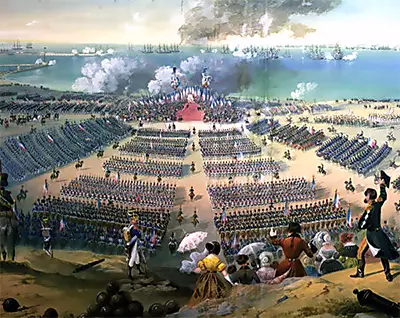The War of the Third Coalition
Part 1: From One War to the Next The War of the Third Coalition began in early 1803 in part because of a dispute over Malta. The Treaty of Amiens, which when signed by representatives of France and the U.K. ended the War of the Second Coalition, contained language that required British personnel to leave the island, which they had taken from France. Claiming a sort of quid pro quo with French troops who hadn't yet left ports in Italy, the U.K. forces in Malta refused to leave. The London Government was concerned with other goings-on in 1802 as well, particularly other actions that France had taken, such as assuming ownership of Piedmont and dictating a change in government for the Swiss Confederation–both of which were technically in breach of the Treaty of Lunéville, which had ended the war with all but the U.K. in 1801. On May 18, 1804, the Senate passed a bill proclaiming that France was an Empire and that Napoleon Bonaparte was its Emperor. His coronation ceremony occurred on December 2. Late in that same year, Sweden had abandoned ties with France because of the Duke of Enghien affair. Louis Antoine de Bourbon, the Duke of Enghien and a descendant of King Louis XIV, was said to be involved with a plot to assassinate Napoleon and was arrested and executed. The evidence against him was later found to have been fabricated. In response, Sweden renounced its relationship with France and signed an alliance with the U.K. 
For much of 1803 and 1804, even as a state of war existed between France and the U.K., no battles occurred. The London government was busy pursuing alliances, and the army in France was busy building up an invasion fleet. In 1803, Bonaparte had sold the Louisiana Territory to the United States, in exchange for a large amount of money. He used that money to pay for what was to be an invasion of the U.K. A large army numbering 200,000 trained at Boulogne, Brues, and Montreuil. French engineers and soldiers, along with allies from the Batavian Republic, designed and built invasion barges. Knowing this, the U.K. army fortified their defenses along the coast nearest France, including augmenting existing fortifications and building new ones and cutting the Royal Military Canal, a 28-mile obstacle to any enemy army. As well, U.K. ships continued their blockade of French coastlines and even raided the port of Boulogne in October 1804. Spain had joined France during the War of the Second Coalition and had fought against British forces in the West Indies, with little success; Britain had furthered its dominance by instituting a blockade of Spain as well as of France. The Treaty of Amiens resulted in the lifting of that blockade, but the declaration of war in 1803 brought it back. As a result, Spanish ships sailed with French ships in an extensive feint designed to remove the U.K. Royal Navy from the English Channel. The plan was for the fleets, one French and the other Franco-Spanish, to break through the blockade and cross the Atlantic, to threaten U.K. interests there (much like Bonaparte's plan to divert Britain's attention in 1798 by invading Egypt). One of the fleets made it to its destination, but the other did not; as a result, the U.K. ships shadowing the Franco-Spanish fleet had less to worry about. Another part of the plan that fell through was a planned invasion of Ireland on the way back: When the rendezvous didn't happen, the Franco-Spanish fleet sailed straight back, breaking through the blockade again in order to put in at port. The naval sorties accomplished a whole lot of nothing for France, and Bonaparte, who had overseen an unsuccessful test of the invasion barges some weeks before, abandoned the plan to invade the U.K. and instead directed the large number of troops that had been dedicated to that purpose to pack up and head east. Those orders came in August. It was a few months before, on April 11, 1805, that Russia and the U.K. had signed the St. Petersburg Union Treaty, beginning the Third Coalition. Austria joined forces on August 8. Next page > French Victory in Germany; U.K. Victory at Sea > Page 1, 2, 3 |
|
Social Studies for Kids
copyright 2002–2024
David White




